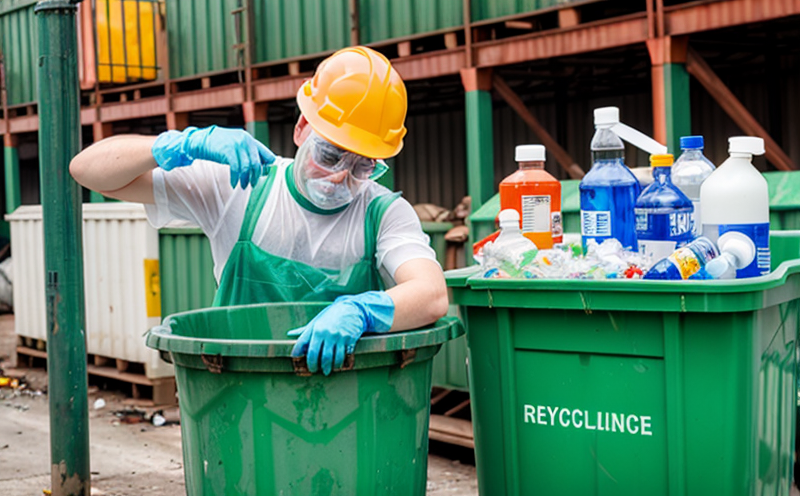EPA 3545 Accelerated Solvent Extraction Testing in Waste
The EPA 3545 method is a widely recognized and standardized approach used for the extraction of volatile organic compounds (VOCs) from solid or semisolid waste materials. This accelerated solvent extraction process employs high temperatures, pressures, and solvents to efficiently extract analytes into a liquid phase suitable for subsequent analysis.
The primary objective of this method is to ensure accurate quantification and characterization of hazardous substances present in waste streams, which is crucial for regulatory compliance and environmental safety. By employing EPA 3545, laboratories can provide precise data on the types and concentrations of VOCs within waste materials, enabling informed decision-making related to recycling, treatment, or disposal.
The test involves several key steps: first, the sample preparation ensures homogeneity by grinding solid waste into a fine powder. This step is critical as it allows for consistent extraction across different samples. Next, extraction occurs under controlled conditions within an extraction cell using pressurized solvents such as methanol or dichloromethane. The choice of solvent depends on the specific VOCs being targeted.
Following extraction, the liquid phase containing the analytes is collected and analyzed via gas chromatography-mass spectrometry (GC-MS), high-performance liquid chromatography (HPLC), or other relevant analytical techniques to identify and quantify the compounds. Reporting typically includes detailed lists of detected VOCs along with their respective concentrations.
This method has been instrumental in supporting various industries including hazardous waste management, environmental remediation projects, and recycling operations where accurate identification and quantification of volatile organic compounds are essential for compliance with local and international regulations.
| Sample Type | Volatile Organic Compounds (VOCs) | Targeted Concentrations |
|---|---|---|
| Solid Waste | Methanol, Toluene, Xylene | <10 ppm for Methanol, <5 ppm for Toluene and Xylene |
| Semisolid Waste | Trichloroethylene (TCE), Dichloromethane (DCM) | <2 ppm for both Compounds |
The precision and accuracy of EPA 3545 are enhanced by rigorous quality control measures such as spike recoveries, method blanks, and reference material calibrations. These controls ensure that the results obtained from this extraction process are reliable and repeatable.
Understanding the intricacies of EPA 3545 is essential for professionals involved in waste management and recycling processes. This knowledge allows them to make informed decisions regarding treatment options based on accurate data provided by thorough testing.
Industry Applications
EPA 3545 accelerated solvent extraction finds extensive application across multiple sectors, particularly in the fields of hazardous waste management and environmental remediation. Here are some key areas where this testing method plays a vital role:
- Hazardous Waste Management: Accurate determination of volatile organic compounds is crucial for proper classification and handling of hazardous materials.
- Environmental Remediation: Identification and quantification of VOCs help in designing effective remediation strategies aimed at cleaning up contaminated sites.
- Recycling Operations: Ensuring that recycled products meet stringent standards regarding the presence of harmful chemicals is paramount, making EPA 3545 an indispensable tool.
- Manufacturing Industries: Monitoring process streams for unwanted by-products or residual solvents can prevent contamination and ensure product quality.
The versatility of EPA 3545 extends beyond these sectors into academia where researchers use it to study the behavior of VOCs under various conditions. Its broad applicability makes it a cornerstone in ensuring environmental compliance and safety across diverse industries.
Why Choose This Test?
Selecting EPA 3545 accelerated solvent extraction for your waste testing needs offers numerous advantages that cater to the specific requirements of different stakeholders involved in environmental compliance and remediation projects.
- Precision: The method provides highly accurate results, ensuring reliable data for decision-making processes related to waste management strategies.
- Efficiency: By utilizing high-pressure solvents at elevated temperatures, EPA 3545 significantly reduces extraction times compared to traditional methods like Soxhlet extraction.
- Rigorous Standards: Adherence to strict international standards ensures consistent and comparable results globally, enhancing credibility in reporting findings.
- Environmental Impact Reduction: Accurate identification and quantification of VOCs enable more efficient resource utilization by identifying recyclable components within waste streams.
These benefits make EPA 3545 a preferred choice among laboratories specializing in waste analysis, offering both precision and efficiency needed to meet regulatory demands effectively.
International Acceptance and Recognition
EPA 3545 accelerated solvent extraction enjoys widespread recognition and acceptance across various international standards bodies, including the United States Environmental Protection Agency (EPA), European Union directives, and other national regulatory authorities.
- ISO/IEC: The method aligns closely with ISO/IEC 17025 standards for calibration laboratories and testing organizations.
- ASTM: Compliance with ASTM D3985 ensures compatibility with established industry practices globally.
- EN Standards: Adoption by European Norms (EN) further underscores its universal applicability within the continent.
The consistent application of EPA 3545 across diverse regulatory frameworks highlights its reliability and effectiveness as a universally accepted practice. This global recognition ensures that results obtained through this method are valid not only domestically but also internationally, facilitating smoother cross-border operations for businesses operating in multiple jurisdictions.





